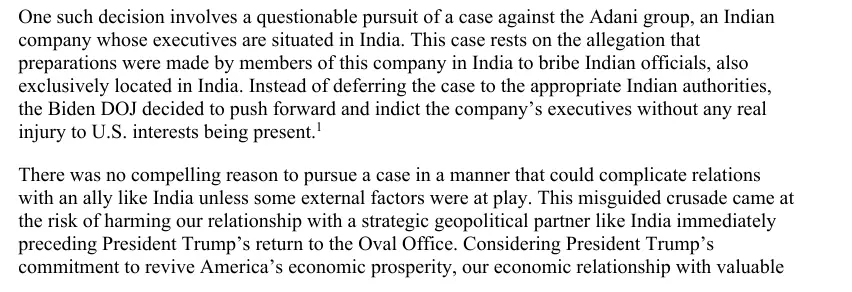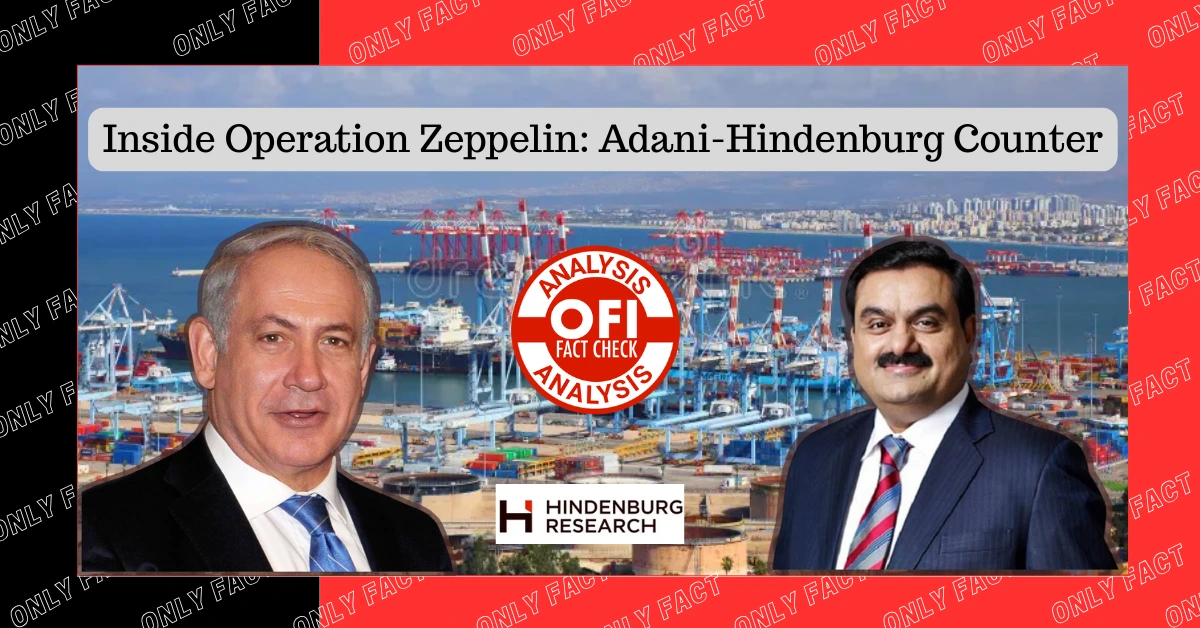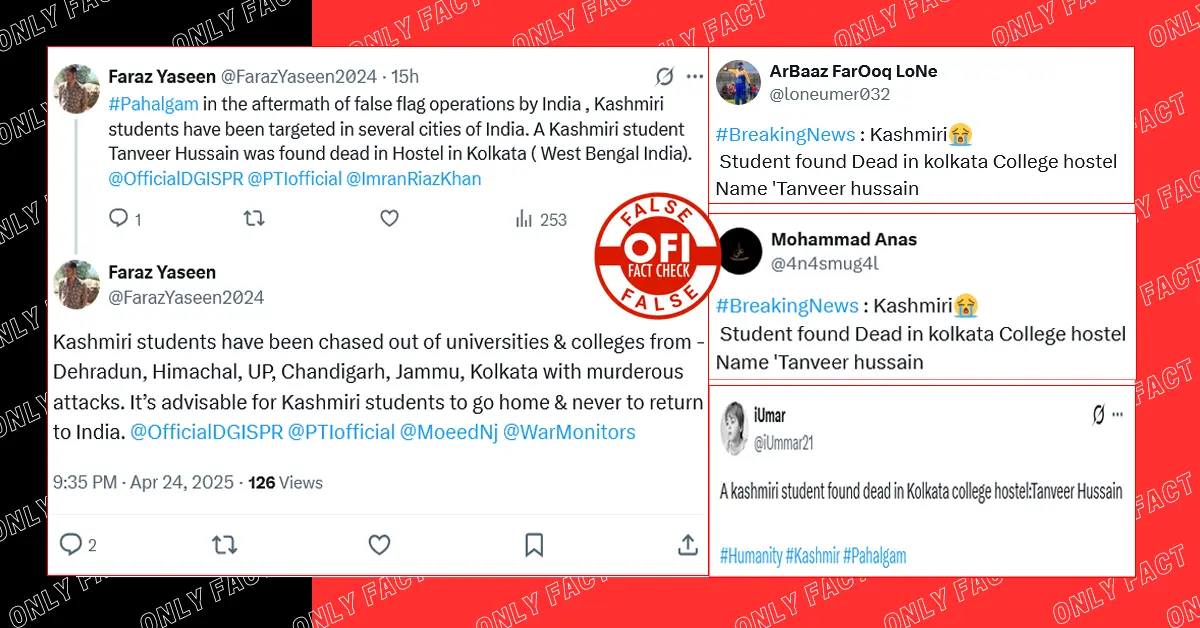India made a remarkable comeback after the COVID-19 pandemic—both economically and in terms of public health. While much of the developed world, including several European nations, struggled to cope, India managed the crisis with greater resilience. China, by contrast, was mired in chaos. As 2022 began, India’s markets were surging, symbolizing the nation’s robust recovery. But on January 24, 2022, that momentum was abruptly interrupted. Hindenburg Research, a notorious U.S.-based short-seller, published a damning report targeting the Adani Group. The fallout was immediate—Adani Group’s shares plummeted, sending shockwaves through the market.
For many Indians, Adani wasn’t just a conglomerate—it was a symbol of the nation’s industrial ascent, akin to what Google and Apple represent to the United States. The Hindenburg report, which appeared deliberately timed to undermine Gautam Adani’s growing influence, ultimately failed to derail his ambitions. Just a week later, on January 31, 2022, Gautam Adani, then among the world’s richest men, extended a firm handshake to Israeli Prime Minister Benjamin Netanyahu, finalizing a landmark $1.2 billion deal for the acquisition of Israel’s largest international seaport. The move cemented the Adani Group’s reputation as India’s leading force in infrastructure, energy, transport, and logistics.
The privatization of Haifa Port marked Israel’s most ambitious infrastructural and financial undertaking of the 2020s. Initially, the sale attracted 18 international bidders, but only five consortiums advanced to the final round. The winning proposal—subject to Israel’s rigorous security clearances—came from a joint venture between Gadot Group and Adani Ports and Special Economic Zone Ltd., with the Indian conglomerate holding the majority stake. The entire process, from bidding to evaluation and final approval, spanned a lengthy 18 months. When the deal was finally sealed, cameras from global media outlets captured the celebratory scenes at the 90-year-old port—a symbolic moment in the deepening partnership between India and Israel.


This is a story of resolve, courage, and unwavering trust—a tale that brings together Gautam Adani, Benjamin Netanyahu, and the shadow of Hindenburg. Take a few minutes to read this narrative of strength and conviction.
Before the historic port deal was signed, Israeli Prime Minister Benjamin Netanyahu held a private meeting with Gautam Adani. Adani arrived alone, while Netanyahu was accompanied by several key figures, including Eshel Armoni, the outgoing chairman of the Haifa Port and a former senior Mossad official.
The conversation turned quickly to the Hindenburg report.
“This report—” Netanyahu began, referencing the explosive allegations, “—it’s a serious threat to your business, isn’t it?”
“Not at all,” Adani replied calmly. “It’s all lies.”
“Yes, we believe it’s fabricated,” Netanyahu acknowledged. “But even if you see no danger, we must remain cautious. If it weakens you, it could undermine not only this port deal but everything we’ve worked to build between India and Israel.”
What followed was neither hesitation nor doubt. Without delay, without questioning each other’s judgment, without the slightest friction, Adani and Netanyahu rose together and shook hands—an act that cut through the noise stirred by the U.S.-based short seller. Their mission wasn’t just to silence the frenzy—it was to confront and eliminate the root of the disruption. Decisively. Completely. In unison.
We all witnessed the chaos the Hindenburg report unleashed on India’s financial markets—it wiped out billions in investor wealth. The report was strategically released during the early hours, while India slept, as if to jolt the nation awake with a fabricated storm swirling around Gautam Adani. The timing was no coincidence.
Soon after, India’s leftist factions and Adani’s political opposition quickly amplified the report, echoing a familiar pattern. Whenever U.S.-based short sellers or investigative outfits like the OCCRP release a report targeting Indian interests, it is often followed by a coordinated digital campaign. At the crack of dawn, just hours before the market opened, a barrage of social media posts appeared—intended not to inform, but to disrupt. A foreign script was being enacted, with willing participants within India.
But behind the noise, a far more consequential story was quietly unfolding.
The financial instability triggered by the Hindenburg report cast a shadow over the $1.2 billion Haifa Port deal—one of the cornerstones of Israel’s long-term plan to deepen its partnership with India and counter China’s expanding influence in the region.
Netanyahu leaned in. “We think this is an indirect attack on Israel. We need to know who is behind this attack. Not just the face—but also the network. The funding. The motive. Israel believes in protecting its friends. We’re going to look into this – very closely.”
The stakes were immense. The Adani Group wasn’t just India’s largest infrastructure firm—it had recently entered a strategic defense partnership with Israel’s Elbit Systems, essential for protecting Israeli lives against threats like Hamas. This wasn’t just business—it was national security.
India and Israel had grown into more than bilateral allies—they were true friends. Even before the G20 Summit in September 2023 formally launched the India-Middle East-Europe Economic Corridor (IMEC), both nations had quietly coordinated a joint implementation plan. The IMEC was conceived as a counter to China’s Belt and Road Initiative and its Red Sea dominance, aiming to reduce transit times by 40%, boost trade efficiency, and lessen reliance on the Suez Canal.
Also Read: No Link Between PM Modi’s Sri Lanka Visit and Adani Group’s CWIT Project
For Israel, the IMEC promised a role as a vital trade hub, deeper regional economic ties, and broader energy and tech collaborations. For India, it meant a faster, more secure trade corridor to Europe—fortifying energy security and counterbalancing China’s expanding geopolitical footprint.
Yet, just as the world was to witness this ambitious plan, the Hindenburg report threatened to upend it all. Adani—the keystone of India’s infrastructure and ports—had been targeted with surgical precision. And it was clear the timing wasn’t accidental.
Gautam Adani and Benjamin Netanyahu understood that they might not yet have the whole story, but they knew exactly where to begin. And from that understanding was born Operation Zeppelin—a covert mission led by two elite Mossad divisions. Tzomet, experts in human intelligence, and Keshet, masters of advanced cyber operations, were assigned a clear goal: dismantle the framework behind Hindenburg Research and unmask the forces funding it.
This was no longer just about business. It was about sovereignty, security, and strategic future. The mission was clear. The stakes were national. And the resolve—unbreakable.
Mossad’s Hunt for the Truth Behind Hindenburg
A few days after the financial storm broke out in India, halfway across the world in New York City, something quiet—but deadly serious—was unfolding. On a regular afternoon, a plain-looking man walked into Ray’s Barber Shop, tucked just off Broadway on W 207th Street. As the barber trimmed his hair, the man kept his eyes locked on a building across the street. It was an old five-story structure. Nothing special. Except for the green awning over its entrance—painted with a simple number: 631.
Behind that doorway was the headquarters of Hindenburg Research, led by Nathan “Nate” Anderson, a financial analyst in his late 30s. In just five years, Anderson had built Hindenburg into a powerful short-selling machine. They made millions by targeting companies with explosive reports—crafting accusations into polished narratives that could shake global markets.
But this time, they had crossed a line. And somewhere far away, in Tel Aviv and Delhi, powerful people were watching.
Soon, agents from Israel’s elite intelligence agency Mossad were on the ground. They weren’t just spies—they were sayanim, civilians secretly working with Mossad, recruited and trusted by top handlers known as katsas. Their mission was simple: watch, listen, infiltrate. One by one, they tracked the faces entering and leaving Hindenburg’s building. Late at night, they installed hidden surveillance devices—under door frames, in vents, even in the alleyways. Nothing escaped their eyes.
Early reports started trickling in. What Mossad found was startling. Hindenburg wasn’t acting alone.
They were getting steady intel from a network of shadowy players: activist lawyers, independent journalists, freelancers funded by NGOs linked to George Soros, rival Indian tycoons with political axes to grind, and even rogue elements from the Biden administration. A few bankers, hedge fund managers and even operatives linked to the Chinese Communist Party had bet big against Adani—and they wanted to win, no matter the cost.


But that wasn’t all. The string-puller at the heart of the drama? A well-known figure from a fading Indian political dynasty. Once powerful, now bitter, this man saw both Adani and Modi as obstacles to his return. At a private meeting in Palo Alto before a Stanford speech in May 2023, he told Anderson’s team, “Hindenburg will finish Adani and Modi.”
Meanwhile, Mossad’s cyber division, Keshet, picked up a digital trail. They tracked a suspicious online identity—someone who kept appearing in encrypted chats between the Indian operatives. The trail led them 800 miles west to a quiet neighborhood in Oakbrook Terrace, near Chicago.
On a quiet Saturday afternoon, as the target left home to attend a funeral nearby, a black van rolled up outside his house. Inside the van there were Mossad’s best hackers.
They broke into his private server. The system was poorly protected. Within minutes, they found what they were looking for: emails, files, chat logs. A goldmine. They installed stealthy monitoring tools hidden inside fake ransomware—nobody would ever know they were inside.
What they uncovered was explosive. Encrypted messages connected Anderson and Hindenburg to offshore bank accounts, shady investment firms, and coordinated anti-Adani cells spread across India, the U.S., Europe, Canada, and Australia.
And then, the message that changed everything: “We must weaken Adani’s position in critical markets. Nate’s report was just the beginning. More’s coming.”
This was no ordinary financial hit job. This was war—waged in silence, in code, and in shadows.
The Counterstrike
After uncovering the dark web of motives behind the Hindenburg report, Gautam Adani struck back—with unyielding force. In India, the tide had already begun turning in his favor. The market was recovering, and Indian shareholders, rallying behind the Adani Group, restored momentum to the soaring shares. A Supreme Court-appointed investigative committee, after thorough scrutiny, found not a shred of substance in the allegations leveled by foreign players.
In January 2024, during a private visit to Switzerland, Adani was briefed in person by senior Israeli officials. The updated Mossad report—codenamed The Zeppelin Dossier, revealed a vast, sophisticated campaign designed to derail Adani’s global ambitions. The findings exposed the coordinated involvement of three major market operators: one based in Mumbai, another in New York, and a third in Toronto. By July, the Indian operator, a prominent banking and financial firm, admitted to being an unwitting pawn of the American hedge fund, which was allegedly backed by Chinese interests. The Canadian entity, however, has yet to acknowledge any role in the operation.

What shocked Adani the most was the hidden hand of one of India’s most powerful business houses—an entity closely aligned with U.S. Democrats and India’s oldest political dynasty. With this knowledge, Adani launched a decisive counteroffensive. He swiftly assembled an elite team of legal experts and intelligence consultants to work in tandem with Mossad operatives. Strategically, he engaged his allies in Washington, leveraging personal ties to key China critics and senior officials in the Biden administration, to create a diplomatic shield against future assaults. Ever the tactician, Adani identified fault lines within the U.S. Democratic camp: the divide between anti-China hawks and pro-China sympathizers. He decisively aligned with the former.
Back in Ahmedabad, Adani transformed a corporate wing into a full-fledged war room—a high-tech command center equipped with AI-powered analytics, private cloud servers, and real-time global intelligence feeds. The digital forensics team worked around the clock, sifting through petabytes of data to trace the roots of the attack.
By October 2024, the Zeppelin Dossier had grown to 353 pages, implicating not only Hindenburg Research but also a long list of co-conspirators: Indian politicians, including a prominent woman parliamentarian; activist lawyers and journalists; foreign-funded NGOs in India and Australia; and mainstream media outlets such as the OCCRP, Bloomberg, Reuters, The Guardian, and the Financial Times. The report identified these actors as part of a coordinated effort to discredit Indian businesses and destabilize the nation’s economic rise—an agenda we, too, have exposed in our earlier reports.
Fully aware of the network aligned against him, Adani and Mossad prepared for the next phase of Operation Zeppelin. In early November 2024, a plain brown envelope was discreetly delivered to an address inside a triangular office complex on Avenue Ledru-Rollin in Paris. Inside were hundreds of explosive documents. The addressees: three senior journalists at Mediapart, France’s leading investigative publication.
The contents were damning: conclusive evidence showing that the U.S. State Department, through USAID, had been influencing and even controlling the editorial decisions of the OCCRP. Identical packets were simultaneously sent to editorial offices of The Guardian, Reuters, Financial Times, Bloomberg, German broadcaster NDR, Il Fatto Quotidiano, Drop Site News, and Reporters United.

Unsurprisingly, though deeply revealing, only three outlets joined Mediapart in publishing the explosive exposé. The rest chose silence, quietly burying the story. Worse still, they tipped off their contacts within the Biden administration’s USAID, ensuring that the trail of accountability vanished before it could reach the public eye.
The Strategic Counterstrike That Toppled Hindenburg
Hindenburg had picked the wrong fight—and this time, there was no escape. In a twist of fate that echoed the story of Chandragupta pushing back Alexander at the gates of India, Gautam Adani’s response was swift and powerful. In November 2024, just as the French newspaper Mediapart was about to reveal serious information, the Biden administration already on shaky ground made a last-ditch effort to go after Adani. They tried a legal double strike, using selected officials at the US Department of Justice (DoJ) and the Securities and Exchange Commission (SEC) to build a case.
But the case had cracks from the start. Adani’s lawyers quickly pointed out how the DoJ accused him of fraud based on someone else’s supposed wrongdoing under the Foreign Corrupt Practices Act and yet didn’t actually charge Adani under that law. The whole thing felt off. Even so, opposition parties in India and their supporters tried to amplify the US case to score political points at home.

The move backfired. India hit back hard, even calling out the US State Department openly. Just weeks later, Breon Peace, the US attorney behind the charges, resigned without much explanation. Around the same time, Adani’s legal team quietly prepared to go on the offensive. A serious legal warning seven pages long and prepared by a top-tier New York law firm was delivered to Nathan Anderson, the man behind Hindenburg Research.
Realizing there was no way out, Anderson and one of his aides met with Adani’s legal intermediaries at a Manhattan office on Fifth Avenue. There, a deal was struck: Hindenburg Research would shut down for good, and Anderson would close his firm in exchange for avoiding a long and damaging lawsuit.
The timing was crucial. Trump had just won re-election, and the winds in Washington were shifting fast. With Adani known to have strong ties to the Trump camp, Anderson and others realized their political protection was gone.
On 15 January 2025, just one week before the two-year mark of Hindenburg’s first attack on Adani, the firm officially shut down. Publicly, it was described as a voluntary move to pursue “new opportunities,” but those close to the matter knew better. The shutdown was part of a quiet deal, meant to bring an end to the campaign against Adani.
Then came more fallout. On 2 February 2025, Jason Gray, acting head of USAID, placed 60 top officials on paid leave. Elon Musk, now in charge of the new government body DOGE (Department of Government Efficiency), didn’t hold back. On social media, he called USAID “a criminal organization” and added, “Time for it to die.”
Just days later, six US lawmakers sent a sharp letter to Attorney General Pamela Bondi, calling the case against Adani “questionable” and urging her to investigate how the Biden team handled it. That same week, Trump signed an executive order freezing enforcement of the Foreign Corrupt Practices Act and telling the DoJ to write new rules for dealing with foreign companies suggesting that cases like Adani’s could be dropped entirely.

Conclusion:
What began as a financial hit job spiraled into one of the most dramatic geopolitical face-offs of the decade. The Hindenburg report wasn’t just about stocks or business ethics—it became a symbol of deeper global power games, where billion-dollar interests, sovereign ambitions, and covert strategies clashed on the world stage.
At the center of this storm stood Gautam Adani—targeted, cornered, but never defeated. His comeback wasn’t just driven by market confidence or legal muscle—it was backed by something far more formidable: allies who believed in more than just profit. Israel, led by Prime Minister Benjamin Netanyahu, saw through the façade early on. For them, this wasn’t merely about a port deal or a business partner—it was about national interest, strategic alignment, and a friend under fire.
With the help of Mossad, Israel’s legendary intelligence agency, Adani didn’t just survive the onslaught—he turned the tide. Operation Zeppelin, run jointly by elite Israeli units and Adani’s own digital war room in Ahmedabad, unmasked a sprawling global conspiracy. What followed was a series of quiet victories—legal, political, and strategic that ultimately silenced one of the most aggressive short-seller campaigns in recent memory.








